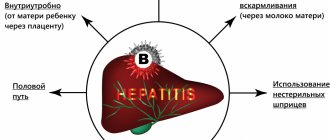Hepatitis is an inflammatory disease that affects cells and liver tissue. The disease is caused by viruses and infections; all age categories of people are at risk of infection.
There are many forms of this liver pathology, which can be diagnosed using a blood test. Depending on the manifestation of symptoms and the nature of the disease, acute and chronic stages of hepatitis are distinguished. The first option, with proper treatment, can be cured quite quickly, but the chronic stage, without proper therapy, develops into cirrhosis of the liver.
Types of hepatitis
Not only viruses, but also parasitic microorganisms, pharmacological agents toxic to the liver, as well as a malfunction of the immune system can provoke the development of hepatitis. Depending on the nature of origin, renal anomalies are divided into five types.
Variations of hepatitis:
- Botkin's disease (A) is the most common type of disease. It is characterized by a long incubation period from 7 to 50 days. A patient who has recovered from this form of hepatitis develops immunity to all other types. B (HBV) - has a 10% permanent threshold. Symptoms may be similar to acute respiratory infections. The incubation period of the virus is about 2-3 months.
- C (HCV) – in 80% of cases the anomaly becomes chronic. Symptoms appear after a week, sometimes after 3 months. The disease can be combined with other types of hepatitis. There is no vaccine for this type of kidney pathology.
- D (HDV) – often develops simultaneously with hepatitis B, the disease severely affects the liver. The latency of the disease is up to 7 weeks.
- E (HEV) - this type of hepatitis is extremely dangerous for pregnant women. In most cases it is fatal. Residents of Africa and Central Asian countries are at risk.
Any variation of hepatitis is dangerous to health and requires proper treatment. Timely vaccination will help avoid the consequences of liver diseases.
Hepatitis C: what a patient needs to know
Hepatitis C is one of the most insidious and deadly viruses. In 90% of cases, they are asymptomatic. Due to its ability to disguise the true cause under the guise of many other diseases, it was nicknamed the “gentle killer.” If the disease does make itself felt, its active phase is divided into two main periods: pre-icteric and icteric. In the first (early) period, symptoms characteristic of viral infections are observed, such as:
- general weakness;
- skin itching;
- digestive disorders: nausea, vomiting, diarrhea;
- increase in body temperature up to 38°C;
- headaches, myalgia, arthralgia.
In the second (icteric) period, when the liver is affected, a large amount of bilirubin, a yellow pigment, is released into the blood. It is thanks to the icteric staining of the patient’s skin that it becomes obvious that he has obvious problems with the liver, and a set of laboratory tests of blood, urine and feces is prescribed.
However, many cases of infection are asymptomatic, without a characteristic clinical picture. After an incubation period, which lasts from a couple of weeks to a couple of months, the patient may not even suspect that he is a carrier of the virus not only in the prodromal (pre-icteric) stage, but also in the icteric stage - due to its absence as such. For example, in 2/3 of all cases, hepatitis C occurs in an atypical (anicteric, or subclinical) form.
Causes and methods of infection with hepatitis
Botkin's disease is transmitted through household contact with household items, dirty hands and unwashed foods; in general, it has a fecal-oral route of transmission. Hepatitis A goes away quickly and without noticeable consequences. Other variations of the disease belong to the parenteral group (C, D, and so on); they may not manifest themselves for a long time, but subsequently torment a person throughout his life, contributing to the development of cirrhosis or even liver cancer. Transmitted mainly through blood during transfusion.
Methods of infection with hepatitis:
- Intrauterine route - transmitted from mother to fetus.
- The use of one syringe by many people is the main way of infecting drug addicts.
- Sexual intercourse is how hepatitis B is mainly transmitted.
- If non-sterile instruments were used during ear piercing or tattooing.
- Impact of toxic substances on the body, etc.
The symptoms of each variant of hepatitis are different; almost always the patient feels fatigue, a headache may appear and the temperature may rise. During the progression of Botkin's disease and other types of illness, yellowness of the skin occurs. A blood test helps identify the disease.
Immunological analysis
During the immune test for HIV, hepatitis and syphilis, specific interactions between antibodies and antigens are studied. The targeted nature of the study allows you to determine whether markers of hepatitis are present in the blood. Immunological analysis also helps to establish blood type and identify parasitic diseases and hormonal disorders.
Modern medical institutions offer to undergo a verified study using the immunoblotting method. This test combines ELISA with electrophoresis and is therefore considered very effective. The immunoblotting method allows you to group pathogen antigens by molecular weight.
Norms of blood tests for hepatitis
Diagnosis of hepatitis primarily consists of examining the patient’s blood; a general analysis and examination of the level of enzymes, antibodies and antigens are required.
Standards and deviations:
- Hepatitis A - blood is tested for the presence of IgG antibodies, the indicator should be less than 1 S/CO. Deviations from the norm indicate the presence of a virus or a previous illness.
- B – there should be no LgM virus antibodies in the blood; a positive result confirms the diagnosis of hepatitis.
- C – the ELISA method is used for diagnosis. If the results contain antibodies to the HCV virus, a repeat test is performed; if the test is positive, the diagnosis is confirmed.
- D – the algorithm for conducting a blood test is similar to the previous option.
During a blood test for non-viral hepatitis, an examination is carried out for bilirubin (normal 5-21 µmol/l), fibrinogen, total protein and other indicators.
Antibody production
The human immune system is a unique indicator of health. Our body produces special cells - antibodies, which help fight various viruses and infections. The production of antibodies is a rather long process (from 14 to 22 days), and the presence of bad habits slows down the production of protective cells.
If the analysis is carried out between the suspected infection and the appearance of antibodies, then even a negative result does not guarantee the absence of the pathogen in the body. A carrier of the virus is potentially dangerous to others, so if you come into contact with an infected person, the test must be taken no earlier than the 23rd day. In this case, the result will be reliable.
Preparing for and taking a blood test for hepatitis
A few days before the test, you need to give up alcohol, go on a diet, eliminating spicy, fatty, and fried foods from your diet. Blood is drawn from a vein strictly on an empty stomach; you can only drink clean still water. If the patient uses pharmacological drugs, he must notify the doctor about this.
To take a blood test for hepatitis, contact the President-Med medical centers in Moscow and Vidnoye
Why is the analysis carried out?
People decide to get tested for HIV and hepatitis for a variety of reasons. Most often, such an examination is mandatory for patients preparing for surgery and women registered for pregnancy.
Another important reason is unprotected sex with an unfamiliar partner. In addition, regular testing is mandatory for medical and educational workers, as well as for workers in production and service sectors.
At the first warning signs, laboratory testing should be performed. This helps confirm or rule out infection. With the development of HIV and hepatitis, the liver receives the first “blow”. Any abnormalities in liver function are a reason to be wary and get tested for HIV, hepatitis and RV.
STI
This test shows the presence of live bacteria as well as the levels of white blood cells, red blood cells and protein in the urine that may accompany a PPI.
Before using the test, ensure that the test strip and urine sample are at room temperature. It is recommended to use the first morning urine, but without the first part of the stream.
You can do this in two ways: start urinating, and after one or two seconds place the strip under the stream. It is important that urine reaches all areas of the strip. The second option is to dip the strip in a container of urine, but you need to remove it immediately so as not to dissolve the reagents.
Results should appear in two minutes.
Specific tests for HIV infection
For a patient who decides to undergo testing for HIV and hepatitis, the doctor should tell them about the specifics of the procedure. PCR is one of the specific diagnostic methods that allows you to isolate DNA and RNA of the pathogen. During the study, blood plasma components are subjected to special treatment. This helps increase the concentration of viral molecules.
Today, patients have the opportunity to undergo rapid testing at home. A person concerned about alarming symptoms can either confirm his assumptions or refute them. If the test result is positive, the patient must be re-examined in the laboratory.
Are there any contraindications for taking such tests?
No. Contraindications are determined by the threat to health during manipulation, so there are none for rapid tests.
But in people with acute infectious diseases or exacerbations of chronic ones, with autoimmune and oncological pathologies, and in pregnant women, the risk of getting a false positive result is higher. False-negative responses are recorded more often than in the population in people with immunodeficiency conditions.
Biochemical method
Biochemical analysis helps determine whether there are metabolic disorders. In addition, this study can assess the extent of liver damage. Most laboratories can perform this test.
What indicators do experts pay special attention to:
- Glucose level. Excessive values indicate liver pathologies, diseases of the immune or endocrine system.
- Potassium level. An increased concentration of potassium is a sign that the hepatitis pathogen is present in the blood. It negatively affects the kidneys and causes dehydration.
- Albumin level. Elevated albumin levels indicate liver and kidney damage.
In the presence of the causative agent of AIDS, biochemical analysis shows a reduced number of leukocytes and platelets with a high rate of red blood cell combination.
Is it worth buying all the tests in a row?
No. The number of examinations should be correlated with the indications and the presence of risk factors.
For example, according to Daria Panieva, self-examination for tuberculosis, Helicobacter pylori and STDs using rapid tests is uninformative without a comprehensive assessment of clinical manifestations and medical history: “A positive result in this case may indicate not only the presence of the disease, but also a past infection " On the other hand, Daria adds that “only an obsession with the issue of self-diagnosis can do harm. Everything should be in moderation. And, of course, sweeping test systems off the shelves and examining yourself and all family members, including the cat, once every three months is impractical. Still, there must be indications for examination. Excessive anxiety is a reason to seek help from a specialist.”
False positive result
No research method can be called absolutely accurate. In case of a false positive result, compounds are present in the blood, the structure of which is similar to that of the pathogens HIV and hepatitis. In this case, the doctor prescribes a repeat test for the patient or selects a more accurate research method. If HIV is suspected, immunoblotting is performed.
To make a diagnosis, the doctor must be confident in the reliability of the data obtained, otherwise treatment will be ineffective. A false positive HIV test result can be caused by:
- There was a history of sexually transmitted diseases and/or viral hepatitis.
- Allergic reaction.
- Inflammatory processes and neoplasms in the kidneys and intestines.
- Hormonal disorders, changes in the enzyme composition of the blood.
With hepatitis, the probability of a false positive result is 15%. Causes:
- Medicine.
- Features of immunity.
- Increased amount of cryoglobulins.
- Autoimmune diseases.
- Low antibody concentration and low viral load in the early stage of hepatitis.
- Presence of heparin.
- Pregnancy.
- Presence of tumors.
- Severe infectious diseases.
- Human factor - errors of medical personnel during storage, transportation and analysis of biomaterials.
- Vaccination against influenza and tetanus.
- The presence of functionally defective proteins in the blood.
Using diagnostic tools from a single manufacturer helps avoid inaccurate results.
That is, always remember that the test is wrong?
Yes. There are no tests that would guarantee a 100% result without requiring a visit to the doctor.
“All rapid test results must be confirmed in the laboratory. Self-testing is a way to increase the detection of primarily asymptomatic chronic infectious diseases. For example, according to WHO, only half of people living with HIV know their status. Many are not examined in health care institutions because they are afraid of condemnation and rejection. This is especially true for teenagers. The ability to test in a comfortable environment and anonymously is an excellent alternative in such situations. You will only need to seek medical help if you receive a positive result.”









